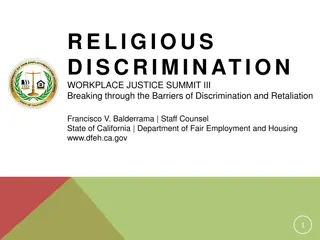Using Google Data to Measure Cross-National Religious Differences
Exploring how Google data can provide insights into religious differences across nations, this research investigates the limitations of traditional survey methods and the potential of social media for social science research. By leveraging Google and Twitter data, researchers can access geocoded information and analyze trends over time, even in countries with limited resources. This approach offers a novel way to study religious dynamics on a global scale.
Download Presentation

Please find below an Image/Link to download the presentation.
The content on the website is provided AS IS for your information and personal use only. It may not be sold, licensed, or shared on other websites without obtaining consent from the author. Download presentation by click this link. If you encounter any issues during the download, it is possible that the publisher has removed the file from their server.
E N D
Presentation Transcript
Using internet derived data to measure religion: Understanding how Google can provide insight into cross-national religious differences Professor Amy Adamczyk, John Jay College and The Graduate Center, City University of New York Jacqueline Scott, John Jay College and The Graduate Center, City University of New York Professor Steve Hitlin, University of Iowa
Outline Limitation of Traditional Survey Methods Potential of Social Media Examples of Using Social Media for Social Science Research Analysis Summary Future Research
Limitation of Traditional Survey Methods Limitation of Traditional Survey Methods
Limitation of Traditional Methods Limitation of Traditional Methods
Limitation of Traditional Methods Limitation of Traditional Methods
Limitation of Traditional Methods Limitation of Traditional Methods
Limitation of Traditional Methods Limitation of Traditional Methods
Limitation of Traditional Methods Limitation of Traditional Methods
Limitation of Traditional Methods Limitation of Traditional Methods Dangerous and remote
Potential of Internet and Social Media Accessing Twitter and Google is relatively easy Data are geocoded we know the country where people reside Google and Twitter provide information on a sample taken from the public The time period can be specified changes over time Most countries (even very poor ones) have people using Google and Twitter
Previous research Searches for Cecil the lion to assess the power of public opinion to change nation-level policies regarding trophy hunting (Carpenter and Konisky, 2017) Searches of interest in political candidates to predict national elections (Swearingen and Ripberger, 2014) Use an internet-based measure of area racism to assess Black mortality (Chae et al., 2015) And many more studies .
Previous research Searches for Cecil the lion to assess the power of public opinion to change nation-level policies regarding trophy hunting (Carpenter and Konisky 2017). But, very little has been done cross-nationally Searches of interest in political candidates to predict national elections (Swearingen and Ripberger 2014) Use an internet-based measure of area racism to assess Black mortality (Chae et al. 2015) And many more studies .
Big data may be able to provide new cross- national religion measures Religion is meaningful to people all over the world. Religions use unique terms for which people are likely to search There are established measures that can be used to validate religion big data Current religion estimates are difficult and costly to determine
Aims of current study Assess the cross-national validity of Twitter and Google against traditional estimates for the five major religions Hinduism, Buddhism, Islam, Christianity, and Judaism. Determine if there are other religion measures that can be validated. Examine the influence of the new and old cross-national religion measures on outcomes that they should explain. Provide a roadmap of best practices for other researchers to use these data
Twitter and Google analytics: how do they work? Not an absolute number, Normalized index of the proportion of all searches on all topics for a specific period and place Each data point is divided by the total searches of the geography and time range it represents Resulting an index from 0 to 100 Relative popularity based on topic s proportion to all searches and topics
Twitter and Google analytics: how do they work? Ratio between Twitter users and count Users from the associated country who posted a tweet containing a string matching one of the keywords in the dataset Count of the number of users who tweeted from the associated country, regardless of their tweets content Twitter ratio (Users/Count) Normalized indicator measuring the number of users in Twitter population who tweeted from a country AND posted a tweet containing a keyword
Language Google topic searches allow searches in all languages. Twitter does not have this option. Twitter searches in this study were done in English.
Analysis Goal Validate Google and Twitter measures against existing country-level estimates for the proportion Hindu, Buddhist, Jewish, Christian, and Muslim, as well as other religion-related terms. Assess how well Google measures perform against traditional measures in multivariate analyses. Data used to validate Pew Research Center Survey Data World Values Survey World Christian Database (ASARB stored at ARDA)
Analysis Concurrent Validity: when the predictor and criterion data are collected at the same time Typical cut-off is a correlation of 0.70 we want this! We start with a focus on Google Trends (GT) GT time period is from 2012-2019 A range of years has higher validity than a single year.
Google Trends search terms examined Major Religions Buddhism Christianity Hinduism Islam Judaism Religious Texts Bible Quran Religious Buildings Buddhist Temple Catholic Church Christian Church Church (Building) Hindu Temple Mosque Synagogue Praise Prayer Worship Religious Holidays Christmas Diwali Easter Eid al-Fitr Holi Parinirvana Day Passover Ramadan Vesak Yom Kippur Religious Terms (Specific) Gautama Buddha Incense Meditation Brahma Kosher Foods Sari Shiva Stupa Vishnu Religious Subcategories Anglicanism Catholicism Eastern Orthodox Church Protestantism Secularism Religious Terms (General) Atheism Divorce Faith Glory (Religion) God
Correlations between GT and traditional measures Muslim Christian Hindu Jewish Buddhist GT searches Ramadan Christmas Holi Passover Buddhist Country N 240 240 240 240 240 WCD % 0.9630*** 0.7936*** 0.8834*** 0.9735*** 0.8486*** Country N 228 228 228 228 228 WVS % 0.9649*** 0.8532*** 0.8835*** 0.9801*** 0.8329*** Country N 191 191 191 191 191 Pew % 0.9595*** 0.8580*** 0.8694*** 0.9721*** 0.8285*** Country N 219 219 219 219 219
Correlations between GT and traditional measures Muslim Christian Hindu Jewish Buddhist GT searches Ramadan Christmas Holi Passover Buddhist Country N 240 - These are the Google search terms that had the largest correlations for the proportion of residents who belong to these religions. 240 240 240 240 WCD % 0.9630*** 0.7936*** 0.8834*** 0.9735*** 0.8486*** Country N 228 228 228 228 228 WVS % 0.9649*** - Correlations range from 0.82 to 0.98 0.8532*** 0.8835*** 0.9801*** 0.8329*** Country N 191 - These Google search terms can be validated against traditional data! 191 191 191 191 Pew % 0.9595*** 0.8580*** 0.8694*** 0.9721*** 0.8285*** Country N 219 219 219 219 219
How do the GT measures perform in a multivariate context and relative to traditional measures Outcomes differ by religion: Islam-GT searches for mosques and human sexual activity; fertility and circumcision rates; and feeling that premarital sex is never justified Christianity-GT searches for Christianity and Bible, and alcohol consumption Buddhism-GT searches for Buddhist Temple Hinduism-GT searches for Hindu Temple Judaism-GT searches for Synagogue
Control variables Human Development Index Income Gini coefficient Political rights and civil liberties Mobile cellular subscriptions English is the official language Access to electricity Same set of controls and nations in every model
OLS Regression analysis for Muslims (controls are included) Searches for Mosque (GT) Fertility rates (DHS) Circumcisio n rates (DHS) Searches for "human sexual activity" (GT) Premarital sex never justified (WVS) 27.540*** 0.136* a 24.638*** 0.189*** a 9.368***a Muslim % standardized (WCD) 27.686*** 0.167*** 28.785*** 0.174*** 11.769*** Topic searches for 'Ramadan' standardized (GT) ***p<0.001, ** p<0.01, *p<0.05, + p<0.10 a=p<0.05 significant difference between WCD and GT measures for the same outcome GT=Google Trends; DHS=Demographic and Health Surveys, WCD=World Christian Database; WVS=World Values Survey
OLS Regression analysis for Christians (controls are included) Searches for Christian Church (GT) Alcohol consumption per capita (WHO) 2.180*** a Searches for Bible (GT) 26.769***a 27.067*** a Christian % standardized (WCD) Topic searches for 'Christmas' standardized (GT) 33.287*** 2.729*** 36.055*** ***p<0.001, ** p<0.01, *p<0.05, + p<0.10 a=p<0.05 significant difference between WCD and GT measures for the same outcome GT=Google Trends; WCD=World Christian Database; WHO=World Health Organization
OLS Regression analysis for Hindus, Jews, and Buddhists (controls are included) Searches for Hindu Temple (GT) Searches for Synagogue (GT) Searches for Buddhist Temple (GT) Hindu % standardized (WCD) 9.819*** 8.913*** Topic searches for 'Holi' standardized (GT) Jewish % standardized (WCD) 4.002*** 3.919*** Topic searches for 'Passover' standardized (GT) Buddhist % standardized (WCD) 8.396*** 8.211*** Topic searches for 'Buddhism' standardized (GT) ***p<0.001, ** p<0.01, *p<0.05, + p<0.10; WCD=World Christian Database; GT=Google Trends a=p<0.05 significant difference between WCD and GT measures for the same outcome
Google search terms examined Praise Prayer Worship Major Religions Buddhism Christianity Hinduism Islam Judaism Religious Texts Bible Quran Religious Buildings Buddhist Temple Catholic Church Christian Church Church (Building) Hindu Temple Mosque Synagogue Other Google Trends search terms? The ones already presented Ramadan, Holi, Passover, Christmas, and Buddhism had the highest correlations. Religious Holidays Christmas Diwali Easter Eid al-Fitr Holi Parinirvana Day Passover Ramadan Vesak Yom Kippur Religious Terms (Specific) Gautama Buddha Incense Meditation Brahma Kosher Foods Sari Shiva Stupa Vishnu Religious Subcategories Anglicanism Catholicism Eastern Orthodox Church Protestantism Secularism Religious Terms (General) Atheism Divorce Faith Glory (Religion) God No other measures produced a correlation above 0.70
Twitter? There were very few measures that could be validated.
Summary of GT findings: GT topic searches for the five major religions can be validated against traditional data (i.e., WVS, WCD, Pew) GT measures also explain things that they should. For most outcomes, we found either the same or significantly high coefficients than traditional measures. Aside from these GT topics (i.e., Ramadan, Holi, Passover, Christmas, and Buddhism) we were unable to validate other measures. We may not have the right traditional data for validation. Many surveys ask about opinions, which are not captured with GT searches
Summary of Twitter findings: Twitter measures could not be validated. Less use of Twitter around the world. Uneven coverage. Cannot search all languages/topics at once (like GT can) The Twitter interface is more challenging than the GT search engine, which is user friendly with point and click options. Use GT searches!
Future Research GT data are a black box, but the more researchers use them, the more we understand how they work. Internet-based data may be especially helpful for examining deviant topics (rape, racism, sex, pornography, etc.) Less prone to social desirability Respondent driven More studies that can move beyond simple validation are needed to explain new phenomena (e.g. UFOs, paranormal interest).



































